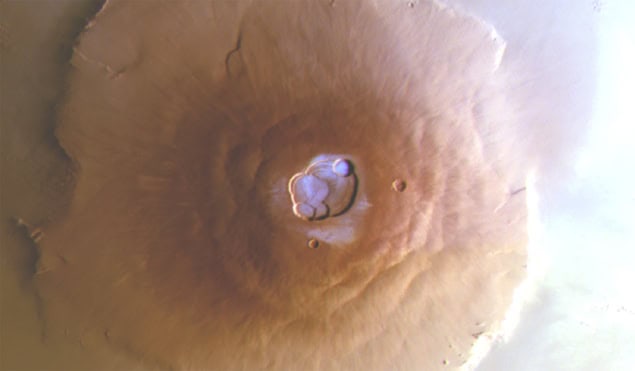
Climbers on Mars’ equatorial volcanoes would wake up to frost-covered peaks, but aspiring Martian scuba divers would find no liquid water beneath the planet’s polar ice caps – contradicting previous reports. These findings, from two independent teams, tell us more about where water does and doesn’t exist on the red planet, with important implications for its climate.
While the temperature and pressure on Mars are too low for liquid water to exist on its surface, scientists have long suspected that the planet could harbour an ocean beneath its ice caps. In 2018, researchers in Italy found strong evidence for such an ocean in data from ESA’s Mars Express spacecraft. The smoking gun (or should that be “flowing gun”?) in this case was a strong radar echo picked up by the Mars Advanced Radar for Subsurface and Ionosphere Sounding instrument (MARSIS) instrument during a survey of the planet’s south pole. The presence of this echo indicates an abrupt change in the dielectric permittivity of material beneath the planet’s surface – and on Earth, this kind of change typically occurs at the interface between solid and liquid water.
Mars is not Earth, however, and other scientists have since proposed alternative explanations. The latest of these alternatives is described in Science Advances and comes from Daniel Lalich and colleagues at Cornell University in the US. Using radar reflectivity simulations, the Cornell scientists showed that the MARSIS echo could be due to constructive interference generated as a radar pulse passes through tightly-packed layers of dusty ice. While they cannot definitively rule out the presence of liquid water, Lalich says, “we’re showing that there are much simpler ways to get the same observation without having to stretch that far, using mechanisms and materials that we already know exist” on Mars.
An ice surprise
As for frost on Martian mountains, the evidence for this comes from a study that compared high-resolution colour images taken by another ESA spacecraft, the Trace Gas Orbiter, at different times of day and in different seasons. During colder seasons, images taken in the morning show bluish deposits atop the four volcanoes in the Tharsis group near the planet’s equator: Olympus Mons, Arsia Mons, Ascraeus Mons and Ceraunius Tholus. Images taken in the afternoon, however, show no such deposits, leading an international team of planetary scientists to conclude that the deposits must be frost.

The long road to Mars
For Earthbound observers, the idea that frost might appear on high ground overnight, only to melt by the afternoon, might not sound so remarkable. But again, Mars is not Earth, and in a Nature Geoscience paper on the study, the scientists note that “the presence of frost at the tropics…was not expected because of higher average surface temperatures and lower humidity”. The team speculate that hollow depressions known as calderas at the volcanoes’ summits create unique microclimates, allowing thin patches of frost to form overnight even at low latitudes. They also conclude that the source of the frost is more likely to be atmospheric than volcanic due to its strongly seasonal pattern.
- SEO Powered Content & PR Distribution. Get Amplified Today.
- PlatoData.Network Vertical Generative Ai. Empower Yourself. Access Here.
- PlatoAiStream. Web3 Intelligence. Knowledge Amplified. Access Here.
- PlatoESG. Carbon, CleanTech, Energy, Environment, Solar, Waste Management. Access Here.
- PlatoHealth. Biotech and Clinical Trials Intelligence. Access Here.
- Source: https://physicsworld.com/a/mars-has-frost-covered-mountains-at-its-equator-but-no-lakes-at-its-poles/



